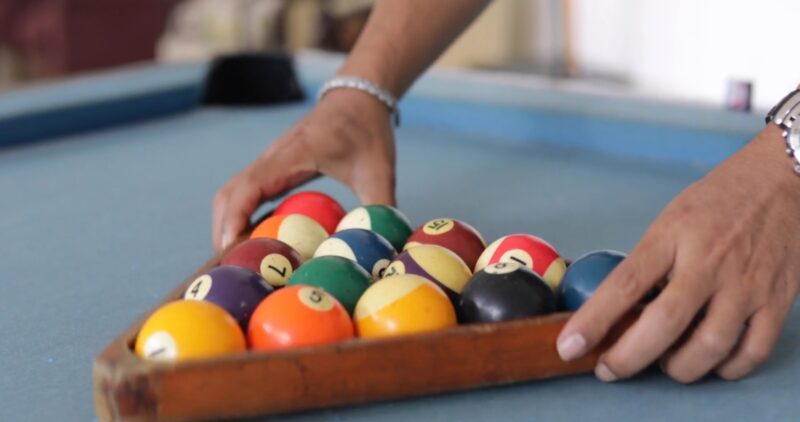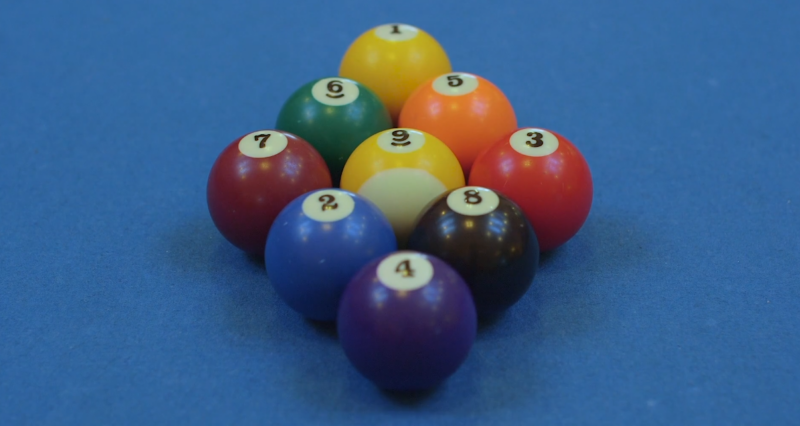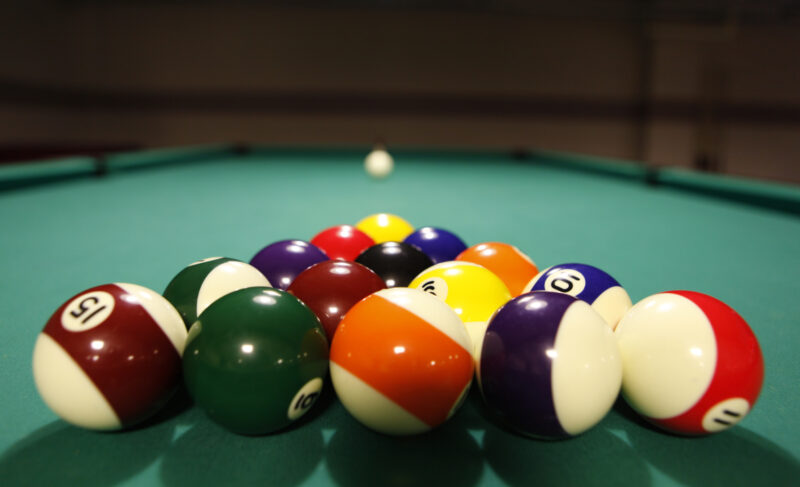Billiards, more commonly known as pool, is a game that dates back centuries, blending skill, strategy, and a touch of luck. One crucial element to start the game off right is the rack.
Mis-racking can affect the game’s outcome, so understanding the proper technique and strategy behind racking pool balls is imperative for any player, beginner or expert.
In this guide, we’ll provide all the information you need to ensure you start your games off correctly every time.
The Standard Ball Set

The standard pool ball set consists of 15 object balls and a cue ball. These 15 balls are differentiated by numbers and colors, making them essential for different pool games. There are seven solid-colored balls (numbers 1-7), seven striped balls (numbers 9-15), and the black 8-ball.
Familiarizing yourself with each of these balls is the first step in understanding the racking process.
What’s the Purpose of This Process?
Racking serves two primary purposes. Firstly, it organizes the balls into a tight formation, allowing for a fair and challenging break. Secondly, the arrangement dictates the game being played, whether it’s 8-ball, 9-ball, or another variant.
The idea is to ensure that balls scatter evenly on the break, providing both players equal opportunities to pocket them. An improperly racked set can provide undue advantages, disrupting the game’s essence.
The Triangle Rack
Traditional pool games use a triangular rack to hold and arrange the balls. The triangle rack is a simple frame, usually made of plastic, wood, or metal, designed to hold all 15 object balls. Its design ensures the balls sit snugly, minimizing gaps between them.
The triangle’s three points cater to different parts of the setup. The apex (topmost point) is where the first ball sits, while the base (two bottom points) accommodates the last row of balls.
How to Use It?
To use the triangle rack effectively, place all 15 balls inside it. Adjust and shuffle the balls to ensure they sit closely together, reducing gaps. Position the triangle so its apex sits on the table’s foot spot—a marked spot towards the table’s center.
Once satisfied, slowly lift the triangle rack to leave the balls in a tight formation. A flawless rack ensures minimal movement and balls roll back into position if slightly nudged.
Racking for 8-Ball
8-Ball is among the most popular pool games, requiring a specific racking pattern. Let’s break it down.
The 8-Ball Setup
In 8-Ball, the rack’s pattern isn’t entirely strict, but some general rules apply. The 8-ball must sit in the triangle’s center, while a stripe and a solid should be at the two bottom corners. Other than these rules, the remaining balls can be placed randomly.
However, many players prefer alternating stripes and solids to ensure a more even dispersion during the break. Similarly, in chess, the kings never directly engage in combat, highlighting the importance of strategy and understanding the rules.
Strategy Behind the 8-Ball Rack
While racking for 8-ball, the strategy plays a subtle role. Placing specific balls near the apex can affect the breaking player’s approach. Some prefer positioning challenging balls closer to the rack’s top, complicating the break.
Others believe in a randomized setup, arguing that a genuine game tests adaptability over predetermined strategies. Either way, ensuring a tight formation remains paramount.
Racking for 9-Ball
9-Ball is another pool variant with unique requirements. Unlike 8-Ball, the arrangement is more systematic.
The 9-Ball Setup

For a 9-ball game, only the balls numbered 1 through 9 are used. The 1-ball is placed at the triangle’s apex, and the 9-ball sits in the center. The other balls can be positioned randomly within the rack. This pattern ensures both predictability and randomness in the game.
The initial target, the 1-ball, is always at the forefront, while the game-winning 9-ball is nestled safely in the middle.
Strategy Behind the 9-Ball Rack
The racking strategy in 9-Ball revolves around ball dispersion. Since balls must be pocketed in numerical order, a tight rack ensures the balls scatter, creating a challenging table after the break.
Proper strategy prevents clusters, which could make runs easier for experienced players.
Advanced Techniques
As players progress, they often adopt nuanced racking strategies. These can sometimes straddle the line between skill and gamesmanship.
Pattern Racking
Pattern racking involves placing the balls in specific sequences or patterns to gain a perceived advantage. While this can be viewed as strategic in casual play, it’s frowned upon in professional settings.
Some tournaments even have rules against specific patterns, emphasizing a random ball arrangement.
Tightening the Rack
One advanced technique is ensuring the front three balls (the apex and the two immediately behind it) are as tight as possible. This formation is believed to optimize the break’s impact, scattering the balls more effectively.
Achieving this often requires meticulous adjustments. Players might minutely nudge balls using their fingers or cue, ensuring maximum compactness.
Common Mistakes
1. Leaving Gaps
Arguably the most prevalent racking error, leaving gaps between balls is a subtle misstep with significant consequences. When balls aren’t touching or closely packed, they fail to transfer energy efficiently during the break.
Small spaces, even if they seem insignificant, can dramatically alter the break’s dynamics. For instance, a gap in the front three balls can hinder the optimal transfer of force, leading to an ineffective spread.
Worse still, gaps often lead to clusters of balls that remain bunched together, making subsequent shots challenging and limiting strategic play options.
What to Do?
Eliminating gaps between balls requires a combination of technique, practice, and sometimes even tools.
- Use of a Racking Cloth: Sometimes, the table’s cloth can have inconsistencies leading to imperfect racking. Using a thin racking cloth or pad can help ensure balls sit more uniformly.
- Press and Rotate Technique: After placing the balls inside the triangle, press down lightly on the top ball and gently rotate it. This action often nudges the surrounding balls, eliminating tiny gaps.
- Check for Table Imperfections: A worn-out or uneven table can cause balls to settle imperfectly. Ensure the table is level and the cloth is free from debris or irregularities.
- Practice: Like all skills, practice makes perfect. Spend time racking and checking for gaps regularly. Over time, you’ll develop a feel for creating a tight rack.
2. Incorrect Ball Placement
In games governed by specific racking rules, like 8-Ball and 9-Ball, the arrangement isn’t merely ceremonial—it’s strategic. Incorrect placement, especially of pivotal balls, can skew the game’s balance.
Misplacing key balls, such as the 8 in 8-Ball or the 9 in 9-Ball, can grant the breaking player unintended advantages. For example, placing the 8-ball closer to the pocket in an 8-Ball game could provide an easier early-game win opportunity.
On the contrary, burying it deep within the rack might make the endgame unnecessarily tedious. Furthermore, with the 9-Ball in the center, its position determines the game’s progression since potting it can lead to an instant win.
An off-center placement could either make this too easy or unduly challenging, both of which detract from the game’s essence.
How to Solve This?
Ensuring correct ball placement relies on knowledge, attentiveness, and sometimes, specific tools.
- Know the Rules: Familiarize yourself with the game’s specific racking rules. Whether it’s 8-Ball, 9-Ball, or any other variant, know where each ball should be placed.
- Use of Racking Templates: Some modern pool halls and tournaments now use racking templates. These are thin sheets with cutouts for each ball, ensuring perfect placement and spacing every time.
- Consistency in Approach: Develop a consistent approach to racking. Start with key balls like the 8 or 9 and then fill in the others. This routine reduces the chance of oversight.
- Visual Checks: Before removing the triangle or template, visually inspect the setup. Ensure the pivotal balls are in the right spots and that the arrangement matches the game’s requirements.
FAQs
Why do some players tap the balls with their cue after racking?
Tapping or lightly pressing on the balls with the cue tip is a method some players use to ensure the balls are settled properly on the tablecloth. It’s believed to help in creating a tighter rack by ensuring all balls are in full contact with the table surface.
Can using a different rack material, like wood versus plastic, affect the racking quality?
The material of the rack itself doesn’t necessarily determine the quality of the rack, but its condition does. A well-maintained wooden rack can provide just as tight a formation as a plastic one.
However, over time, wooden racks can warp or become damaged, leading to imperfect racks, while plastic racks might become brittle and break.
What is the “Magic Rack,” and how does it differ from the traditional triangle rack?
The “Magic Rack” is a racking template made of thin plastic with holes for each ball. It ensures perfect placement and spacing for the balls, providing a consistently tight rack.
Unlike the traditional triangle, which is removed before the break, the Magic Rack often stays on the table during the break and is removed afterward.
Is there a specific side of the triangle rack that should face upwards when racking?
Most triangle racks are symmetrical, so they don’t have a specific “up” side. However, some racks may have branding or logos on one side. As long as the rack holds the balls securely and allows for a tight formation, either side can face upwards.
How can I tell if the table’s “foot spot” is correctly positioned?
The foot spot is typically located at the midpoint between the center pocket and the end rail of the table. In professional settings, this spot is often marked with a small dot or sticker.
If uncertain, you can measure the table’s dimensions and find the exact center of the playing area’s length to locate the foot spot.
Are there any tools or gadgets to help ensure a perfect rack every time?
Yes, aside from the aforementioned Magic Rack, there are several other tools available. Racking cloths or pads can help balls sit more uniformly. Laser alignment tools can ensure the rack’s apex is perfectly aligned with the foot spot.
These tools, combined with practice and experience, can help achieve a consistent and tight rack.
The Bottom Line
Pool is a game of precision, strategy, and occasionally, serendipity. Just as the artistry of Dungeons & Dragons captivates players with its vivid illustrations, the intricacies of pool demand attention to detail
But like any game, its beauty lies in its fairness and the level playing field it offers to its participants. Proper racking sets that stage.
From my early days of casual games with friends to the more competitive arenas, I’ve realized that the few minutes spent racking can dictate the rhythm and flow of the entire game.
So, the next time you find yourself by a pool table, remember the lessons, the strategies, and the mistakes—and rack those balls with the attention and reverence they deserve.

